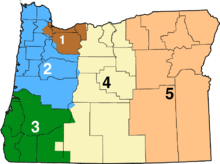Oregon Department of Transportation
.svg.png) | |
| Agency overview | |
|---|---|
| Formed | 1969 |
| Preceding agencies |
|
| Jurisdiction | Oregon |
| Headquarters | Salem, Oregon |
| Agency executive |
|
| Parent agency | Oregon Transportation Commission |
| Website | www.oregon.gov/ODOT |
The Oregon Department of Transportation (ODOT) is a department of the state government of the U.S. state of Oregon responsible for systems of transportation. It was first established in 1969.[1] It had been preceded by the Oregon State Highway Department which, along with the Oregon State Highway Commission, was created by an act of the Oregon Legislative Assembly in 1913.[2] It works closely with the five member Oregon Transportation Commission (the modern name of the Highway Commission) in managing the state's transportation systems.
The Oregon Transportation Commission, formerly the Oregon State Highway Commission, is a five-member governor-appointed government agency that manages the state highways and other transportation in the U.S. state of Oregon, in conjunction with the Oregon Department of Transportation.
Inception
.jpg)
The first State Highway Commission was created on August 12, 1913 and was composed of Governor Oswald West, Secretary of State Ben W. Olcott and Treasurer Thomas B. Kay. On January 12, 1915 James Withycombe became Governor and replaced Oswald West on the commission. The 1917 Oregon Legislative Assembly redesigned the State Highway Commission, with citizens appointed to replace the elected officials.
The new commissioners held their first meeting on March 6, and the commission was then known as the Oregon Highway Division. As Oregon's transportation needs started to grow the division expanded, and in 1919 it employed their first State Bridge Engineer, Conde McCullough.
Achievements
By 1920 Oregon had 620 miles (998 km) of paved roads and 297.2 miles (478.3 km) of plank roads for a population of 783,389, and by 1932 the work that had been started on the Oregon Coast Highway (also known as U.S. Route 101) in 1914 was completed, except for five bridges, which meant greater responsibility for the division. This work was complete when the construction of the bridges over the Yaquina, Alsea, Siuslaw, and Umpqua rivers and Coos Bay were completed, closing the last gaps on the highway. By 1940, the highway division was managing more than 7,000 miles (11,300 km) of state, market and country roads in Oregon, with nearly 5,000 miles (8,000 km) being hard surfaced.

Unusual events
Several unusual events occurred in the department's history. In 1958, the division changed its slogan to the unintentionally funny "Oregon Freeways...Symbol of 2nd Century Progress"[3] and in 1967 ODOT celebrated its 50th anniversary, even though it was by then fifty-four years old. On November 12, 1970, the department gained notoriety after they attempted to dispose of a rotting beached sperm whale by using half-a-ton of dynamite to blast it off the beach, as one might remove a boulder. They were given responsibility for this task because Oregon beaches were designated as highways when the division was initially formed. This became known as the exploding whale incident.
Directors
- John Fulton — July 1, 1969 – December 31, 1970
- George Baldwin — January 1, 1971 – June 30, 1971
- Sam Haley — July 1, 1971 – July 8, 1973
- George Baldwin — July 9, 1973 – April 30, 1976
- Bob Burco — May 1, 1976 – January 8, 1979
- Fred Klaboe — January 9, 1979 – December 31, 1981
- Fred Miller — January 1, 1982 – February 16, 1987
- Bob Bothman — February 17, 1987 – June 30, 1991
- Don Forbes — July 1, 1991 – 1995
- Grace Crunican — 1996 – 2001
- Bruce Warner — 2001 – 2005
- Matthew Garrett — December 19, 2005 – present
State Highway Engineers
- H.L. Bowlby — June 3, 1913 – March 31, 1915
- E. I. Cantine* — April 1, 1915 – May 21, 1915
- John L. Lewis — May 22, 1915 – August 27, 1915
- E. I. Cantine* — August 28, 1915 – January 19, 1916
- John L. Lewis — January 20, 1916 – April 10, 1917
- Herbert Nunn — April 10, 1917 – March 31, 1923
- Roy A. Klein — April 1, 1923 – February 28, 1932
- R.H. Baldock — March 1, 1932 – August 15, 1956
- W.C. Williams — August 16, 1956 – November 30, 1961
- Forrest Cooper — November 30, 1961 – June 30, 1970
- R.L. "Rod" Porter — July 1, 1970 – December 31, 1971
- Tom Edwards — January 1, 1972 – December 31, 1972
- I. Fred Klaboe — January 1, 1973 – May 31, 1976
- H. Scott Coulter — June 1, 1976 – August 4, 1985
- Lawrence W. Rulien —- September 9, 1985 – January 1, 1988
- Don Forbes — February 22, 1988 – January 31, 1992
- Bill Anhorn — February 1, 1992 – 1993
- Ken Husby — 1993 – 1997
- Tom Lulay — 1997 – 2001
- Cathy Nelson — 2001 – 2013
- Tom Lauer, 2013 to present
Slogans[3]
- 1913 - "Get Oregon Out of the Mud"
- 1957 - "Building Oregon Thru Better Highways"
- 1958 - "Oregon Freeways...Symbol of 2nd Century Progress"
- 1961 - "Freeways are Easier"
- 1967 - "Fifty Years of Building Better Highways in Oregon" (not technically correct; the department was formed in 1913)
- 1978 - "Keep Oregon Green and in the Black"
- 1986 - "ODOT on the Move"
- 2006 - "The way to go!"
See also
- Glenn Jackson, an influential 20 year member of the commission
- Oregon Department of Aviation
References
External links
 Media related to the Oregon Department of Transportation building at Wikimedia Commons
Media related to the Oregon Department of Transportation building at Wikimedia Commons- Oregon Department of Transportation Museum online
- Oregon Transportation Commission